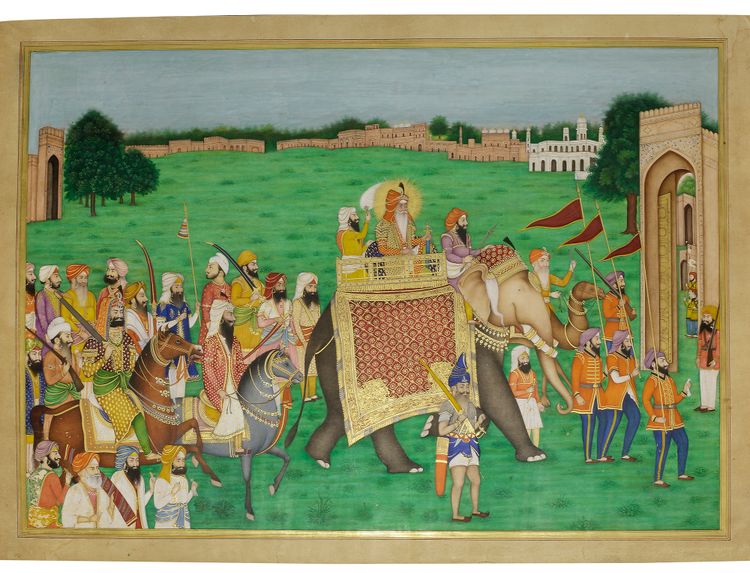MAHARAJA RANJIT SINGH OF PUNJAB IN PROCESSION, 19TH CENTURY
Opaque pigments and gold on paper, within an inner golden border and an outer ivory border.
Probably by a royal court artist of the Punjab Rulers.
Lahore School, Punjab, 19th century.
51 by 35.5 cm.
PROVENANCE
Private collection, Germany.
CATALOGUE NOTE Maharaja Ranjit Singh of Punjab (b. 1780, reg. 1801-1849) rides a richly caparisoned elephant as its mahout with a goad in his hand, while an attendant seated behind him holds the requisite chowrie.His two sons Raja Kharak Singh & Raja Sher Singh follow on decorated horses. Soldiers with appropriate emblems and standards march in front with a more renowned group of nobles and attendants behind. The procession takes place in a green landscape and seen in the distance are palaces and houses of the city.
Painting in the Punjab up to the middle of the nineteenth century had been largely the domain of artists from the Punjab Hill states, lured by the prospect of patronage to the great cities of Lahore and Amritsar (see Archer). Simple portraits or decorative pictures for their Sikh patrons changed possibly under the influence of British taste after the annexation of the Punjab in 1849 into more genre-orientated pictures, slices of real life apparently painted by Sikh artists, as well as portraits in more up-to-date taste of what remained of the Sikh nobility. These are naturalistic and highly decorative as in the painting of Maharaja Ranjit Singh in the Bazaar in the Hodgkin Collection (Topsfield, no. 77) or Dost Muhammad being entertained in Lahore in the Kapany Collection (Stronge, fig. 189). A painting in the same style signed by the artist Bishan Singh of the court of Ranjit Singh is dated 1864 (Christie’s London, 7 October 2008, lot 245), worked in the Punjab in the nineteenth century (pp. 41-59) known Sikh artists as Kehar Singh, Kishan Singh (Stronge 1999, fig. 203and Kapur Singh (ibid., fig. 199). They were based in Amritsar and were equally adept at wall paintings as well as paintings on paper and even in oils. These Amritsar families of artists were called upon by the local nobility to decorate their palaces, particularly those in Patiala.
References Stronge, S., ed., The Arts of the Sikh Kingdoms, London, 1999 Topsfield, A., Visions of Mughal India: the Collection of Howard Hodgkin, Oxford, 2012

